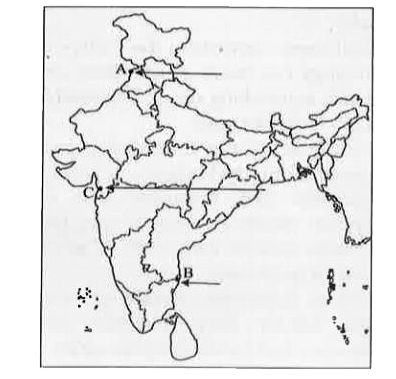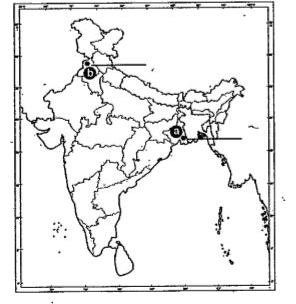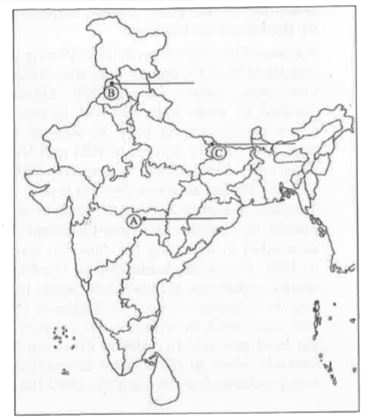A song on the Jallianwala Bagh incident in 1919 was composed by IPTA (Indian People's Theatre Association), which of the following lines from that song reflects India's essential unity?
Having fallen to bullets, we slept in Jallianwala Bagh
The blood of Hindus and Muslims flows together today
Do light a lamp on this lonely grave
The hunter has torn away every single flower
The correct Answer is:B
Similar Questions
Two features a and b are marked on the given political outline map of India. Identify these features with the help of the following information and write their correct names on the lines marked near them.
(a) The place where the Indian National Congress Session was held.
(b) The city where Jallianwalla Bagh incident took place.
(B) Locate and label any three of the following with appropriate symbols on the same given outline political map of India.
(i) Kalpakkam-Nuclear Power plant
(ii) vijaynagar -Iron and Steel Plant
(iii) Noida -Software Technology Park
(iv) Paradeep -Sea port
(v) Sardar Sorovar -Dam
View SolutionDirections: Study the following information carefully and answer the question given below:
In an international meet, representatives A, B, C, D, E, F G and H from eight different countries, viz Thailand, France, Holland, Austria, US, Spain, India and Germany (not necessarily in the same order), sit around a circular table facing the centre. A, who represents Germany, sits third to the left of E. The one who is from India sits on the immediate right of A. D, who is from Holland, sits second to the right of B. B is not an immediate neighbour of E. C, who is from Spain, sits exactly in the middle of people representing US and India. G, the representative from France, sits second to the left of H, who is from Thailand.
The representative from which of the following countries is seated second to the left of the Indian representative?
1) Thailand
2) VS
3) France
4) Spain
5) None of these
View Solution
Knowledge Check
Read the passages carefully and select the best answer to each question out of the given four alternatives.
Culture is defined as a people.s way of life. It entails how they dress, how they speak, the type of food they eat, the manner in which they worship, and their art among many other things. Indian culture, therefore, is the Indians. way of life. Because of the population diversity, there is immense variety in Indian culture. The Indian culture is a blend of various cultures belonging to diverse religions, castes, regions follow their own tradition and culture. Indian Culture is one of the oldest cultures in the world. India had an urban civilization even during the Bronze Age. The Indus Valley Civilization (Harappan Civilization) dates back to 3300 BC-1300 BC. Distinct cultures different from each other co-exist together in a single country. Thus, in India, there is unity amidst vast cultural diversity. The way people live in India is reflected in its culture. India is a land of unity in diversity where people of different sects, caste and religion live together. India is also called the land of unity in diversity as different groups of people co-operate with each other to live in a single society. Unity in diversity has also become the strength of India.
According to the passage, which of the following is TRUE about unity in diversity?AUnity in diversity has also become the strength of India.BIndia used to be a land of unity in diversity.CIndians have moved on from unity in diversity thing.DUnity in diversity is a unique feature of India.Which of the following statements with regard to freedom struggle are correct?
1. The British rule could prevail in India on the basis of the consent or acquiescence of many sections of Indian people.
2. The social basis of the colonial regime was among the Zamindars and upper classes.
3. The Indian National Army forced the British to with from India.
4. The Hindu Mahasabha supported the partition of India.
Select the correct answer using the code given below:
Code:A1 and 2B2 and 3C3 and 4D1, 2, 3 and 4As the news of Jallianwaila Bagh spread, crowds took to the streets in many north Indian towns. There were strikes, clashes with the police and attacks on government buildings. The government responded with brutal repression, seeking to humiliate and terrorise people: satyagrahis were forced to rub their noses on the ground, crawl on the streets, and do salaam (salute) to all sahibs, people were flogged and villages (around Gujranwala in Punjab, now in Pakistan) were bombed. Seeing violence spread, Mahatma Gandhi called off the movement. Answer the following MCQs by choosing the most appropriate option.
When did Jallianwala Bagh incident took place.AApril 13, 1919BApril 14, 1918CApril 15, 1920DApril 13, 1920
Three features A, B and C are marked on the given political outline map of India. Identify these features with the help of the following information and write their correct names on the lines marked on the map
A. The city associated with the Jallianwala Bagh incident.
B. The place where the Indian National Congress session (1927) was held.
C. The place where Gandhiji violated the salt Law.

View SolutionTwo features (a) and (b) are marked on the given political outline map of India. Identify these features with the help of the following information and write their correct names on the lines marked on the map
(i) The place where the Indian National Congress Session was held
(ii) The city where 'Jallianwalla Bagh' incidence took place

View SolutionThree features A,B and C are marked in the political outline map of India.Identify these features witht the help of the following information and write their correct names on the lines marked on the map:
A.The place where the Indian National congress session was held in 1920.
B.The city where the Jallianwala Bagh incident occurred.
C.The place where the peasants struggled against the indigo plantation system.

View SolutionThree features A, B and C are marked on the given political outline map of India. Identify these features with the help of the following information and write their correct names on the lines marked in the map : A. The place where the indian national congress session was held in 1972 . B. The place associated with peasan't satyagraha . C. The city associated with the dallianwala bagh incident .

View SolutionAs the news of Jallianwaila Bagh spread, crowds took to the streets in many north Indian towns. There were strikes, clashes with the police and attacks on government buildings. The government responded with brutal repression, seeking to humiliate and terrorise people: satyagrahis were forced to rub their noses on the ground, crawl on the streets, and do salaam (salute) to all sahibs, people were flogged and villages (around Gujranwala in Punjab, now in Pakistan) were bombed. Seeing violence spread, Mahatma Gandhi called off the movement. Answer the following MCQs by choosing the most appropriate option.
Name the ideology which was being followed due to Jallianwala Bagh massacre,
View Solution
